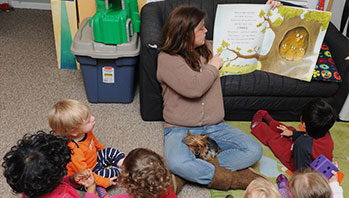- fact
- inclined plane
- move
- ramp
- simple machine
MA Standards:
Reading for Informational Text/RI.P.MA.1: With prompting and support, ask and answer questions about an informational text read aloud.
Reading for Informational Text/RI.P.MA.3: With prompting and support, represent or act out concepts learned from hearing an informational text read aloud (e.g., make a skyscraper out of blocks after listening to a book about cities or, following a read-aloud on animals, show how an elephant’s gait differs from a bunny’s hop).
Reading for Informational Text/RI.P.MA.4: With prompting and support, ask and answer questions about unfamiliar words in an informational text read aloud.
Reading for Informational Text/RI.P.MA.6: With prompting and support, “read” illustrations in an informational picture book by describing facts learned from the pictures (e.g., how a seed grows into a plant).
Reading for Informational Text/RI.P.MA.10: Listen actively as an individual and as a member of a group to a variety of age-appropriate informational texts read aloud.
Head Start Outcomes:
Literacy Knowledge/Book Appreciation and Knowledge: Asks and answers questions and makes comments about print materials.
Language Development/Expressive Language: Engages in communication and conversation with others.
Language Development/Expressive Language: Uses language to express ideas and needs.
PreK Learning Guidelines:
English Language Arts/Reading and Literature 10: Engage actively in read-aloud activities by asking questions, offering ideas, predicting or retelling important parts of a story or informational book.
English Language Arts/Reading and Literature 13: Relate themes and information in books to personal experiences.
Read Together: Roll, Slope, Slide: A Book About Ramps #1

© Commonwealth of Massachusetts, Department of Early Education and Care (Jennifer Waddell photographer). All rights reserved.
STEM Key Concepts: Identify tools and simple machines used for a specific purpose, e.g., ramp, wheel, pulley, lever
ELA Focus Skills: Book Appreciation, Make Connections, Speaking and Listening, Vocabulary
Discuss the genre of nonfiction. Tell children that nonfiction books have facts or real information about something. Explain that the book you will be reading has information about ramps and how they are used. Set a reading focus for children by having them notice the many different ways a ramp can help people move things.
Before You Read
Display the cover of Roll, Slope, Slide: A Book About Ramps by Michael Dahl. Ask children to point to the title. Read it aloud, tracking the words as you do. Then point to and read the names of the author and illustrator. Have children notice how the curve of the way the words are written make them seem like they are moving. Ask children to point to the ramps they see on the cover.
As You Read
Do a picture walk through the book, pausing to emphasize the vocabulary words.
- Pause to trace the incline of the ramps as you go through the book. Say, Why do you think inclined plane is another word for ramp?
- As you do the picture walk, have children use hand and body motions to demonstrate the meaning of action words and phrases such as gliding, climb into and out of, guide luggage, move packages, lead them, and swoosh.
After You Read
Ask children to connect the pictures to their own lives and to think of other places they have seen ramps used as simple machines to help make work easier for people. If necessary, prompt children with the following ideas:
- wheelchair ramps
- sidewalk ramps
- cement mixer ramp
